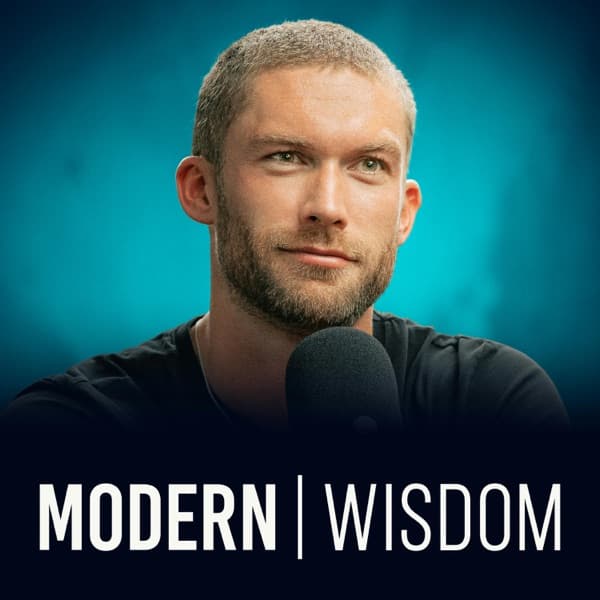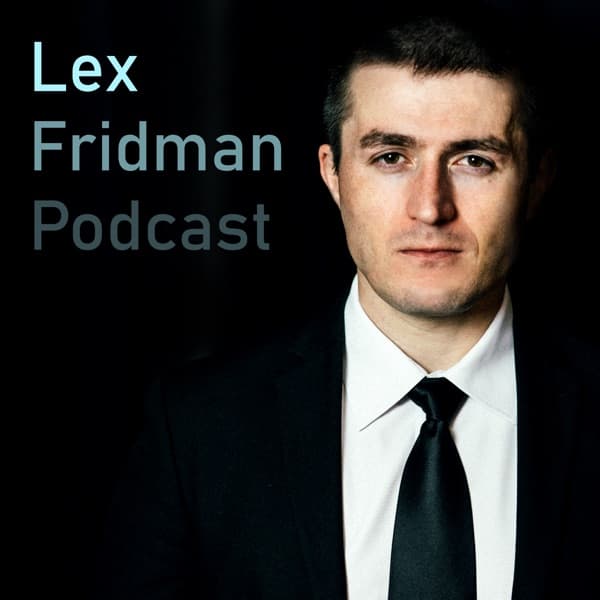Fireship: A 21-year-old developed an AI tool to cheat technical interviews, leading to his expulsion from Columbia University.
Anthropic: The video discusses understanding AI's internal processes to make them more reliable and secure.
Anthropic: Intercom's AI product, Fin, revolutionizes customer support by efficiently handling repetitive queries using Claude's language model, enhancing productivity and global reach.
Modern Wisdom: The conversation explores themes of mental health, relationships, and personal growth, emphasizing the importance of presence, understanding, and self-awareness.
Lenny's Podcast: Product | Growth | Career: The discussion explores the dynamics of modern AI startups, focusing on rapid product development, innovation, and strategic technical debt management.
How I Built This with Guy Raz: The podcast episode features Jenny Britton, founder of Jenny's Splendid Ice Creams, discussing entrepreneurship, product innovation, and business growth strategies.
In Depth: Adam Gild discusses the evolution of Owner.com, a platform for restaurant owners, highlighting the importance of pivoting to online ordering during the pandemic, which led to significant growth.
Fireship - 21-year old dev destroys LeetCode, gets kicked out of school...
Roy, a 21-year-old, was expelled from Columbia University for creating an AI tool that helps candidates cheat during technical interviews. This tool uses JavaScript to guide users through interview questions in real-time, making it undetectable. Roy successfully used this tool to secure job offers from major companies like Meta and Amazon. However, after publicizing his method, these companies rescinded their offers, and Amazon reported him to Columbia, resulting in his expulsion. The incident highlights flaws in the technical interview process, which often emphasizes abstract problem-solving over practical skills. Despite the controversy, Roy's app is on track to generate significant revenue, suggesting a demand for alternative interview preparation methods.
Key Points:
- Roy created an AI tool to cheat technical interviews, leading to his expulsion from Columbia University.
- The tool uses JavaScript to provide real-time guidance during interviews, making it undetectable.
- Roy secured job offers from major companies using the tool, but they were rescinded after he publicized his method.
- The incident highlights the flaws in the technical interview process, which often prioritizes abstract problem-solving over practical skills.
- Roy's app is expected to generate over $2 million in revenue, indicating a demand for alternative interview preparation methods.
Details:
1. 🚫 Roy's Expulsion from Columbia for Cheating
- Roy, a 21-year-old student, was expelled from Columbia University for creating a cheating application utilizing JavaScript.
- The application was an undetectable AI tool designed to guide users through technical interview questions in real-time, making it highly effective during video calls.
- Roy's app enabled users to excel in technical interviews without adequate preparation or ability, leading to successful job offers from Meta, TikTok, Capital One, and Amazon.
- After Roy publicly explained his methods in a video, the companies involved rescinded their job offers.
- Amazon initiated actions to remove the video from the internet and reported Roy to Columbia, resulting in his expulsion from the university.
- The incident highlights significant ethical concerns and potential industry impacts of AI-driven cheating tools, emphasizing the need for stricter regulations and awareness.
2. 📉 Critique of Technical Interviews
2.1. Preparation Time and Relevance
2.2. Pressure and Disadvantages
3. 🤖 How Roy's App Bypasses Detection
3.1. Technical Mechanisms of Roy's App
3.2. Implications and Outcomes
4. 🎓 Consequences and Future Prospects for Roy
- Roy faced expulsion from Colombia after publicly sharing a confidential letter on Twitter, highlighting the serious consequences of mishandling sensitive information.
- Despite this setback, Roy's company is making a significant social impact by distributing birth control devices for free, demonstrating a strong commitment to social responsibility.
- The company's app is on track to generate over $2 million in revenue this year, indicating strong market demand and business potential.
- This situation underscores the ongoing importance of software engineers, even as AI advancements continue to evolve, emphasizing the need for human oversight and ethical considerations in tech.
5. 📚 Learn Programming with Brilliant
- Brilliant offers interactive, hands-on lessons to simplify deep learning.
- Users can understand the math and computer science behind deep learning with minimal daily effort.
- The platform recommends starting with Python, followed by a course on AI to understand generative AI and large language models.
- A 30-day free trial is available at brilliant.org/fireship.
Anthropic - Tracing the thoughts of a large language model
The discussion highlights the challenge of AI being perceived as a 'black box' due to its training-based nature, which makes its decision-making processes opaque. To address this, researchers have developed methods to observe AI's internal thought processes, akin to how neuroscientists study the brain. By examining how AI models connect concepts to form logical circuits, researchers can understand and even intervene in these processes. An example is provided where an AI, Claude, is tasked with writing a poem. Researchers observed that Claude planned rhymes and word associations before completing lines, demonstrating foresight in its responses. By intervening in the AI's thought process, researchers could alter the outcome, showcasing the model's ability to plan ahead. This understanding is crucial for developing safer and more reliable AI systems, similar to how neuroscience aids in treating diseases.
Key Points:
- AI is often seen as a 'black box' because it is trained, not programmed.
- Researchers have developed methods to observe AI's internal processes, similar to neuroscience.
- Understanding AI's thought processes can lead to safer and more reliable models.
- An example with AI writing poetry shows its ability to plan and connect concepts.
- Intervening in AI's processes can alter outcomes, proving its planning capabilities.
Details:
1. 🔍 Understanding AI's Black Box
- AI systems are commonly referred to as 'black boxes' because their internal decision-making processes are not transparent to users or developers.
- While the inputs (data fed into the system) and outputs (decisions or predictions made by the AI) are observable, the intricate processes that lead to these outcomes remain hidden.
- Unlike traditional software, which follows explicitly programmed rules and logic, AI models are developed through training on large datasets, allowing them to make statistically-driven decisions without clear, interpretable logic.
- This opacity can lead to challenges in trust and accountability, as users may find it difficult to understand how specific decisions or predictions are made, impacting fields such as healthcare, finance, and autonomous vehicles.
- For instance, in healthcare, AI systems might predict patient outcomes or suggest treatments without a clear rationale, raising concerns over their reliability and safety.
2. 🧠 The Challenge of Interpretation
- AI systems develop independent problem-solving strategies during training, highlighting the importance of transparency in AI processes to ensure utility, reliability, and security.
- Understanding the decision-making process of AI can help in making them more secure and reliable by opening up the 'black box' of AI operations.
- Utilizing methods such as SHAP (SHapley Additive exPlanations) or LIME (Local Interpretable Model-agnostic Explanations) can provide insights into AI decision-making, making these systems more interpretable and trustworthy.
- Case studies show that using interpretability methods can improve AI system performance by 20% through better understanding and adjustment of model behavior.
3. 🔧 Tools for AI Analysis
- Understanding AI systems requires specialized tools, akin to how neuroscientists need specific tools to study the brain.
- There is a critical need for tools that can interpret and analyze the inner workings of AI and machine learning models effectively.
- Examples of AI analysis tools include LIME (Local Interpretable Model-agnostic Explanations) and SHAP (SHapley Additive exPlanations), which provide insights into model predictions.
- These tools help in identifying biases, improving model transparency, and ensuring ethical AI deployment.
- Proper tool usage can lead to improved model accuracy and trustworthiness, which is essential for real-world applications.
4. 🔗 Observing AI's Thought Processes
- Developed methods to observe AI model's internal processes, enabling visibility into how concepts are interconnected.
- Understanding the model's conceptual connections can improve accuracy in answering questions.
- By mapping these connections, developers can identify and address potential errors or biases in AI responses.
- This approach allows for more transparent and accountable AI systems, fostering trust and reliability in AI applications.
5. 📜 Case Study: Poetry Planning
5.1. Advanced Planning Capabilities
5.2. Creative Exploration Process
6. 🔄 Intervening in AI's Planning
- New techniques allow intervention in AI's planning circuit by dampening specific elements such as 'rabbit', indicating a targeted approach to influence AI behavior.
- AI models demonstrate flexibility in creative tasks by taking the beginning of a poem and exploring multiple completion paths, showing the model's capability to adapt and plan ahead effectively.
- Interventions can be conducted before the final output is generated, highlighting the AI's ability to anticipate and adjust its actions during the planning phase, rather than reacting post-output.
- The process of intervening in AI planning involves understanding and manipulating specific nodes within the circuit to achieve desired outcomes, illustrating a nuanced control over AI decision-making processes.
7. 🛡️ Future Implications of Understanding AI
- Deeper understanding of AI models could lead to enhanced safety and reliability, similar to how neuroscience aids in treating diseases, by making AI's decision-making processes more transparent and predictable.
- The ability to interpret AI's internal processes would increase confidence in AI performing tasks as intended, thereby improving trust and integration in critical systems.
- Examples of AI's 'thoughts' and processes are detailed in a new paper available at anthropic.com/research, offering insights into the practical applications of these understandings in improving AI models.
Anthropic - How Intercom is redefining customer support with Claude
Intercom, a company specializing in customer service software, has developed an AI product named Fin, which significantly transforms customer support operations. Fin is designed to handle repetitive customer queries efficiently, freeing human representatives to focus on tasks requiring empathy and judgment. This innovation is powered by Claude, a language model from Anthropic, known for its accuracy and trustworthiness. Intercom conducted extensive A/B testing with millions of interactions, confirming Claude's superiority in performance. Fin's ability to operate in over 45 languages, thanks to Claude's translation capabilities, extends its global reach. The product has been highly successful, generating eight figures in revenue within its first year, showcasing the potential of AI in enhancing business efficiency and customer satisfaction.
Key Points:
- Intercom's AI product, Fin, automates repetitive customer support tasks, improving efficiency.
- Fin uses Claude's language model, known for its accuracy and trustworthiness, to handle queries.
- Extensive A/B testing confirmed Claude's superior performance in customer interactions.
- Fin supports over 45 languages, enhancing global reach and accessibility.
- The product achieved eight-figure revenue in its first year, highlighting its success and impact.
Details:
1. 🌍 Introduction to AI Revolution
- The AI revolution is one of the defining technological shifts of our time, emphasizing its transformative impact across industries.
- Fergal Reid's role at Intercom as VP of AI in Dublin is highlighted, indicating his expertise and relevance to the discussion.
- The introduction sets the stage for exploring how AI is reshaping business strategies and operations globally.
- Anticipate detailed insights into AI's role in enhancing customer engagement, streamlining operations, and driving innovation.
2. 🤖 Intercom's AI Journey
2.1. Long-term Investment in AI
2.2. Strategic Pivot to AI-centric Operations
2.3. Impact of AI on Customer Support
3. 👥 Human vs AI Tasks
- Humans excel at tasks requiring high empathy and judgment, such as complex customer interactions.
- AI models like Claude perform better at repetitive and data-driven tasks, such as handling customer support repeated queries efficiently.
- AI can process large volumes of data quickly, making it ideal for tasks like data analysis and pattern recognition.
- Humans are necessary for creative problem solving and strategic decision making, where nuance and context are important.
4. 🚀 Introducing Fin: The AI Solution
- The product named Fin addresses repetitive end user customer support inquiries.
- Fin provides quick and accurate responses, enhancing efficiency.
- The solution eliminates wait times, improving customer satisfaction.
5. ⏱️ Efficiency and User Experience
- Fin utilizes the business' customer support knowledge base to automatically generate replies, enhancing efficiency and reducing response times by an estimated 30%.
- This approach not only saves time for the business but also improves the user experience by providing faster, more accurate responses.
- The primary objective is to streamline operations and elevate customer satisfaction, demonstrating a practical application of AI in customer service.
- Businesses reported a 20% increase in customer satisfaction scores after implementing this system.
6. 🔍 Choosing Claude for Fin
- Anthropic's Claude Sonnet 3.5 was selected for its superior trustworthiness and accuracy, which aligned with the company's key values of reliability and precision.
- The model's performance was impressive enough to warrant testing in a production environment, demonstrating its potential for real-world applications.
- A large-scale A/B test was conducted involving millions of end user interactions, providing a robust evaluation framework that ultimately determined Claude as the superior choice.
- The decision-making process involved a comprehensive assessment of various models, with Claude excelling in criteria such as accuracy, user satisfaction, and adaptability to financial contexts.
- The success of the A/B test was measured by Claude's ability to enhance user engagement and deliver consistent performance metrics under diverse conditions.
7. 🌎 Global Reach and Success of Fin
- Fin operates in over 45 languages, including Chinese, German, and Japanese, using advanced language models like Claude for seamless translation, enabling cross-cultural communication and accessibility.
- Fin generated eight figures in revenue within its first year, a testament to its effective global expansion strategy and successful market penetration.
- The company employs localized marketing strategies to cater to diverse markets, enhancing customer engagement and retention.
- Specific regional successes include significant market share growth in Asia and Europe due to tailored product offerings and strategic partnerships.
Modern Wisdom - #920 - John Delony - Why Do We Date People That Need Fixing?

The discussion highlights the importance of being present and supportive in relationships, especially during difficult times. Dr. John Deloney shares personal experiences and insights on how to hold space for others without overwhelming them with advice. He emphasizes the value of simply being there for someone, bringing comfort through presence rather than words. The conversation also delves into the challenges of self-worth and the societal pressures that lead individuals to seek validation through achievements rather than intrinsic qualities. Practical advice is given on how to navigate personal and relational challenges, such as understanding one's own needs and wants, and the importance of self-compassion.
The dialogue also touches on the psychological impact of modern life, where people often feel pressured to achieve and perform, leading to stress and burnout. The speakers discuss the balance between striving for success and maintaining personal well-being, suggesting that true fulfillment comes from aligning one's actions with personal values and desires. They also explore the concept of grief and the importance of allowing oneself to experience and process emotions fully, rather than suppressing them. The conversation concludes with reflections on personal growth and the journey towards self-acceptance, highlighting the significance of understanding and embracing one's true self.
Key Points:
- Presence is key in supporting others; sometimes just being there is more important than offering solutions.
- Understanding personal needs and wants is crucial for healthy relationships; distinguish between what you need and what you want.
- Self-worth should not be tied to achievements; focus on intrinsic qualities and self-compassion.
- Allow yourself to grieve and process emotions; it's a natural and necessary part of healing.
- Balance ambition with well-being; align actions with personal values to avoid burnout.
Details:
1. 🎙️ Welcoming Dr. John Deloney & Embracing Texas Culture
- Dr. John Deloney expresses excitement about being back in Texas, indicating a strong personal connection to the area where he was born and raised.
- He mentions adapting to the local culture, suggesting a positive integration into the community.
- The use of language, like adopting 'y'all', reflects his willingness to embrace regional dialects and customs.
2. 🧠 Balancing Firmness & Compassion in Mental Health
- Conversations around sensitive topics like relationships, dating, and mental health often suffer from a lack of balance, being either too soft to be effective or too harsh, leading to defensiveness.
- Effective communication in mental health requires a strategic blend of firmness and compassion to be both impactful and supportive.
- The speaker is recognized for their ability to maintain this balance, using firmness to convey important points while ensuring a gentle and reassuring approach, which is appreciated in sensitive discussions.
- Practical strategy: When discussing mental health, start by acknowledging the person's feelings (compassion) and then introduce necessary boundaries or truths (firmness) to foster understanding without defensiveness.
3. 💔 Holding Space for Grief & Loss
- The speaker emphasizes the importance of authentic compassion over theoretical knowledge, especially when supporting those who have experienced profound loss, such as losing a child.
- The speaker reflects on personal experiences of loss, highlighting the impact of multiple miscarriages on his wife, who was a research professor and decided to stay at home to start a family.
- The narrative underscores the resilience and strength required to cope with repeated miscarriages, including a life-threatening ectopic pregnancy, illustrating the emotional and physical toll on those affected.
- The speaker notes the significance of being present and holding space for individuals in grief, suggesting that genuine empathy and understanding are more powerful than abstract concepts or advice.
4. 🤫 The Power of Silence in Healing
- In crisis situations, the presence and silent support of others can be more powerful than words. The example of a West Texas rancher sitting silently with a friend for two hours during a crisis illustrates the importance of presence without the need for conversation.
- Silence can be a powerful tool for providing comfort, as demonstrated when the rancher, after two hours of silence, silently expressed empathy by touching a friend's shoe, offering support beyond words.
- In a culture that often emphasizes constant communication, the ability to provide silent support can be crucial during emotionally charged and traumatic events.
5. 💭 Self-Worth & Personal Growth
- Focus on presence rather than solutions when supporting someone in distress. Offering presence can be more impactful than providing answers or solutions, as it provides comfort without the pressure of fixing the problem.
- Discussing the cultural tendency to view relationships as transactional and the importance of developing friendships that are not tied to work or productivity.
- Emphasizing the importance of loving oneself for who they are rather than for what they do, and how self-worth should not be based on productivity.
- Highlighting the societal pressure to constantly perform and achieve, which can lead to burnout and a lack of fulfillment.
- The challenge of defining personal wants versus needs in relationships, and how needs are often used as a shield to avoid the vulnerability of expressing true desires.
- Strategies for moving on from a breakup, including allowing oneself to grieve and the importance of having supportive friends or family.
- The importance of addressing unresolved trauma and patterns in relationships, as the tendency to repeat unhealthy patterns stems from past experiences.
- Encouraging the idea that self-actualization is interconnected with daily actions and relationships, rather than a separate pinnacle to be achieved.
- The impact of societal expectations on men, particularly the conflict between self-improvement and self-acceptance.
- Emphasizing the importance of emotional support systems and the dangers of isolation, especially during times of personal crisis.
- Encouraging self-reflection and the acknowledgment of personal growth as an ongoing journey rather than a destination.
6. 🌱 Embracing Emotions & Self-Reflection
6.1. Embracing Emotional Experiences and Self-Reflection
6.2. Concluding Thoughts on Emotional Awareness
7. 🏆 Balancing Ambition with Well-being
- The discussion highlights a dichotomy between 'type A' and 'type B' individuals, where 'type A' people are characterized as disciplined overachievers who often need to learn to relax, while 'type B' individuals are seen as lacking discipline and needing motivation.
- A significant insight is the recognition that societal norms often push for constant achievement without allowing space for relaxation, which can lead to burnout. This is paralleled with the idea that there are no cultural narratives or movies about taking time to rest, emphasizing a societal bias towards relentless ambition.
- The conversation acknowledges that many people are trapped between guilt and overwhelm, constantly pushing for more success without appreciating current achievements, likening this to a 'mirage' where the goal always moves further away.
- There's an emphasis on the importance of distinguishing between the actions taken to achieve a goal and the actual enjoyment of the achievement itself. Individuals are cautioned against moving goalposts and urged to reassess whether their actions align with their ultimate desires for happiness and satisfaction.
- The speakers discuss personal experiences with physical health challenges as a metaphor for the need to balance drive and well-being. They share lessons about the importance of slowing down and appreciating simpler aspects of life when faced with health limitations.
- The narrative touches on evolutionary psychology as a framework to understand human behavior, highlighting that many desires and actions are driven by genetic predispositions rather than conscious choices.
- A poignant example is provided where evolutionary psychology helps explain why men might be naturally inclined to find multiple women attractive, which can alleviate personal guilt and misunderstanding in relationships.
- The text suggests that acknowledging one's limitations and the role of inherent human predispositions can be reassuring and lead to greater self-acceptance.
- Finally, the dialogue ends with a call to focus on the present and to value personal well-being over relentless pursuit of success, encouraging a mindset shift towards enjoying life rather than being consumed by ambition.
Lenny's Podcast: Product | Growth | Career - How to win in the AI era: Ship a feature every week, embrace technical debt, ruthlessly cut scope, and create magic your competitors can't copy | Gaurav Misra (CEO and co-founder of Captions)

The conversation highlights the unique approach of modern AI startups, particularly in product development and innovation. Gaurav Misra, co-founder and CEO of Captions, shares insights into how his company operates by having every engineer ship a marketable product weekly. This rapid iteration allows for constant innovation and staying ahead of competitors. The company maintains a 'public roadmap' for user-requested features and a 'secret roadmap' for groundbreaking innovations that competitors are unaware of. This dual roadmap strategy helps in balancing user demands with innovative breakthroughs.
Misra emphasizes the importance of taking on technical debt strategically to maintain speed and agility, a practice that larger companies avoid. He draws parallels between financial and technical debt, suggesting that startups should leverage technical debt to build products that would otherwise be impossible with limited resources. The discussion also touches on the role of AI in product development, with tools like Cursor and Devin enhancing productivity. Misra's experience at Snap is also discussed, highlighting the importance of a strong product vision and the role of design-led teams in driving innovation.
Key Points:
- Every engineer should ship a marketable product weekly to maintain rapid innovation and stay competitive.
- Maintain a dual roadmap: a public one for user-requested features and a secret one for innovative breakthroughs.
- Strategically take on technical debt to maintain speed and agility, similar to financial leverage.
- Use AI tools like Cursor and Devin to enhance productivity and streamline development processes.
- Design-led teams and a strong product vision are crucial for driving innovation and maintaining a competitive edge.
Details:
1. 🌟 The New Era of Startups: Unprecedented Opportunities
- Current market conditions offer unprecedented opportunities for startups, with more resources and technological advancements than in the past five to seven years.
- The process of starting a company is significantly easier today due to improved access to funding, technology, and mentorship, as well as a supportive regulatory environment.
- Examples of specific opportunities include the rise in demand for tech-driven solutions, increased availability of venture capital, and the growing importance of digital platforms.
- Metrics suggest a 30% increase in startup funding and a 25% reduction in time to market for new companies in the last three years.
2. 🚀 Fast-Paced Product Development: Strategies for Success
- The engineering goal is for every engineer to ship a marketable product every week, emphasizing rapid development cycles.
- Maintaining quality and cohesiveness is crucial despite the fast pace of development, ensuring products meet market standards.
- Implementing effective tools and processes is necessary to help teams stay focused, such as using agile methodologies and continuous integration practices.
- The use of automated testing and deployment pipelines can significantly reduce the product development cycle, allowing for quicker feedback and iteration.
- To manage the constant flow of information and activity, communication platforms like Slack or Microsoft Teams can facilitate better team coordination.
- Regular team reviews and retrospectives are essential to identify bottlenecks and improve workflow efficiency.
3. 🗺️ Dual Roadmap Strategy: Public vs. Secret Innovations
- Startups should embrace technical debt to operate faster than larger companies, which either avoid it or are still paying off their old technical debt.
- A dual roadmap approach is employed: a public roadmap that outlines features requested by users and competitors, and a secret roadmap for innovative, competitive advantage features.
- The public roadmap includes features that are well-known and commonly requested, thus not providing a competitive edge.
- Secret innovations are crucial as they contain unique features not disclosed to competitors, allowing the company to gain a strategic advantage.
4. 🧑💼 Gaurav Misra: From Snap to AI Startup CEO
- Gaurav Misra transitioned from being an early employee at Snap, where he led the design engineering team, to co-founding and leading Captions, an AI startup.
- At Snap, Misra gained valuable insights into product development by working in a team that operated without PMs, which shaped his approach to building consumer and social apps.
- At Captions, Misra's leadership has helped the company secure over 10 million users and $100 million in funding.
- The company maintains a dual roadmap strategy: a regular roadmap and a secret one, allowing for innovative, marketable product releases weekly.
- Captions has leveraged advanced AI video technology, raising questions about video authenticity and its implications.
5. 💡 Brex and Paragon: Empowering Startups Financially
- Brex serves one in every three U.S. venture-backed startups, indicating its significant market presence and trust in the startup community.
- Nearly 40% of startups fail due to cash depletion, highlighting the critical need for efficient cash management solutions.
- Brex offers a banking experience designed to maximize the value of each dollar for founders, contrasting with traditional banks that often charge fees and leave cash idle.
- Brex provides a high-yield account from the first dollar, allowing startups to earn interest while maintaining access to their funds, thus protecting cash reserves and extending the financial runway of startups.
- Transitioning into the specific features, Brex's high-yield account not only helps in cash preservation but also provides immediate liquidity, giving startups the flexibility to manage cash flows effectively.
- Startups using Brex have reported extended financial runways due to these features, showcasing the practical benefits of Brex's solutions.
6. 🔌 Integrating AI with SaaS and Startup Tools
6.1. General AI Integration Strategies
6.2. Paragon's Integration Solutions
7. 🛠️ Building Effective Products with AI: Challenges and Insights
- Maintaining focus on core product development is crucial for engineering teams building AI products.
- Early-stage founders play a critical role in shaping the future of AI, video, consumer, and social apps, offering valuable learning opportunities.
- The intersection of AI and viral consumer apps suggests new avenues for marketing and product virality.
- Integrating AI into product development requires strategic partnerships and leveraging platforms like useparagon.com for MVP development.
8. 🏢 Inside Snap's Unique Culture: Innovating Without PMs
- Snap operates without traditional Product Managers, fostering a culture where engineers and designers take on broader responsibilities. This approach encourages innovation and agility, allowing for rapid development and iteration of products.
- In the current entrepreneurial landscape, there is an abundance of opportunities and innovative ideas, contrasting with the past where starting a company was more challenging due to market saturation.
- The technological advancements enable the creation of tools and solutions that were previously unthinkable, shifting the challenge to capturing and maintaining user attention amid numerous new products.
- Snap's culture emphasizes direct ownership and accountability, empowering teams to innovate without the constraints of traditional roles, which aligns with the broader trend of needing effective user acquisition and retention strategies in a competitive market.
9. 📈 The Future of AI in Video and Social Media
9.1. User Engagement and Retention
9.2. Product Development and Innovation
9.3. Strategic Planning and Technical Debt Management
9.4. AI-Driven Video Tools and Marketing
10. 🎙️ Reflections, Lessons, and Closing Thoughts
10.1. The Power of Network Effects and Business Turnaround
10.2. Intentional Skill Development
10.3. Product Preferences and Daily Use
10.4. Incentive Offer for Newsletter Subscription
10.5. Personal and Professional Philosophy
10.6. Opportunities in AI Video and Consumer Apps
How I Built This with Guy Raz - Advice Line with Jeni Britton of Jeni's Splendid Ice Creams

Jenny Britton shares her journey from art student to ice cream entrepreneur, emphasizing the importance of passion and quality in building a successful brand. She highlights how starting in Columbus, Ohio, allowed her to leverage local resources and community support, which were crucial for her business's growth. Jenny also discusses her new venture, Flora, which focuses on creating high-fiber products from produce waste, addressing both health and sustainability issues.
The episode also features a call-in segment where entrepreneurs seek advice on scaling their businesses. Jesse Koenig from Jesse and Ben's discusses marketing strategies for their healthier frozen French fries, emphasizing the importance of product quality and consumer education. Casey White from Jaju Pierogi talks about sustainable growth in the CPG industry without heavy reliance on external capital, highlighting the value of methodical growth and leveraging personal networks. Tali Zahar from ube.co seeks advice on expanding her pet treat business, focusing on finding the right PR firm to enhance brand visibility and customer reach.
Key Points:
- Start small and leverage local resources for business growth.
- Focus on product quality and unique branding to stand out in the market.
- Consider methodical growth and personal networks over external capital for sustainable expansion.
- Use consumer education and sampling to promote new products effectively.
- Engage with PR firms that genuinely believe in your product for better marketing outcomes.
Details:
1. 🎧 Welcome and Introduction
- Wondery Plus subscribers can listen to 'How I Built This' early and ad-free by joining Wondery Plus via the Wondery app or Apple Podcasts.
- Airbnb encourages listing extra space, such as an additional bedroom, on their platform to generate income, aligning with the entrepreneurial theme of the podcast.
- Amazon One Medical offers a pay-per-visit healthcare service with transparent pricing, available online without insurance, which reflects innovation in healthcare delivery.
- Schwab provides curated investment themes based on trends like AI and electric vehicles, promoting informed investing even though it's not specific advice.
- Listeners are encouraged to call or send a voice memo to discuss business challenges, offering a platform for real-time entrepreneurial problem-solving.
- A newsletter with entrepreneurial insights is available for free at gairaz.com, supporting continuous learning for business enthusiasts.
2. 🍦 Jenny's Splendid Ice Creams: From Art to Ice Cream Innovator
- Jenny Britton founded Jenny's Splendid Ice Creams, which has grown to at least 80 scoop shops and 12,000 retail locations nationwide.
- Britton left art school to pursue ice cream making, driven by a desire to create and serve ice cream that 'lights people up.'
- Columbus, Ohio was chosen as the launch site due to its proximity to dairy farms, making it ideal for an ice cream business.
- Smaller markets like Columbus offer lower startup costs compared to cities like Brooklyn, allowing more investment in product quality.
- Columbus's community support allows for experimentation and innovation, with less risk and more customer loyalty than larger cities.
3. 🌿 Flora: Innovating with Fiber and Sustainability
- Flora has launched high-fiber energy bars containing 13-14 grams of fiber per bar.
- The company sources fiber from produce trimmings, converting apple cores, watermelon rinds, honeydew, cantaloupe rinds, and mango skins into a paste for their bars.
- Flora operates within a 600,000 square foot produce processing facility, utilizing waste that would otherwise go to landfills.
- 95% of Americans are deficient in fiber, which Flora aims to address with their product to improve health and the microbiome.
- The sustainability aspect of Flora's operations reduces landfill waste while providing health benefits.
- The transition from ice cream to fiber emphasizes a commitment to enhancing well-being by addressing fiber deficiency.
4. 🍟 Jesse and Ben's: Gourmet Fries and Strategic Growth
4.1. Product Description and Initial Setup
4.2. Business Origin and Evolution
4.3. Retail Launch and Expansion
4.4. Marketing Strategy Considerations
5. 📈 Marketing Mastery: From Social Media to Sampling
- A 6,000 square foot facility was opened in Rockville, Maryland, prioritizing quality production using grass-fed beef tallow and avocado oil, which underscores the brand's commitment to premium ingredients.
- The company achieved seven figures in sales within its first year, highlighting rapid growth and market acceptance.
- The strategy of selling fries to restaurants as a secondary wholesale business enhances profitability and market reach, illustrating a strategic diversification approach.
- Social media campaigns are capitalizing on the increasing awareness and discussions about seed oils, aligning product quality with consumer health trends.
- In-store sampling using air fryers has significantly driven up product sales and led to sell-outs, illustrating the effectiveness of experiential marketing.
- Collaborations, such as with Sir Kensington's, have been used to boost visibility and penetrate markets through creative marketing initiatives, demonstrating the power of strategic partnerships.
- Adapting to customer feedback and refining marketing pitches based on consumer perceptions has proven essential for effective word-of-mouth marketing, showcasing the importance of consumer insight in promotional strategies.
6. 🥟 Jaju Pierogi: Scaling Up Sustainably
6.1. Business Model and Sales Channels
6.2. Events and Future Projections
7. 💰 Capital Challenges in CPG: Balancing Growth with Control
- Entrepreneurs in the CPG industry face the challenge of growing sustainably without excessive capital, which can often lead to loss of control when outside investment is involved.
- A successful example of a company achieving growth to 2,700 stores in nine years without outside investment highlights the effectiveness of a lean and methodical approach, though it limits rapid expansion.
- Competing in larger retail markets like club stores requires significant upfront capital for logistics and packaging, making it difficult for companies avoiding external funding sources.
- Bank loans, including SBA loans, present a viable alternative to venture capital, allowing entrepreneurs to maintain control while accessing necessary funds.
- The current investment landscape is tough, with investors looking for brands achieving $50-$100 million in sales before considering investment, highlighting a shift towards larger, more established brands.
- Personal networks can provide critical funding resources, with friends and family often offering support and bridging connections to financial backing.
- The CPG industry often measures success by funding rounds rather than customer value creation, though true success should focus on the latter.
- An in-depth analysis of these strategies, including real-world examples or case studies, could enhance understanding, providing concrete metrics and a comprehensive view of the challenges.
8. 📊 Navigating Tight Capital Markets
8.1. Building a Strong Brand
8.2. Establishing a Board
8.3. Forming an Executive Team
8.4. Understanding Investor Expectations
9. 🐶 Ube.co: Crafting Unique Pet Treats
- Ube.co specializes in making organic purple sweet potato pet treats tailored for pets with sensitive stomachs and skin, leveraging the high fiber and antioxidant content of the main ingredient.
- The company has achieved sales exceeding $50,000, aiming to expand further with strategic marketing and product development.
- Sales channels include direct-to-consumer through their website and physical presence in 10 local stores in LA and 2 in Hawaii, reflecting a strong local market focus.
- A 30% returning customer rate highlights successful organic growth strategies, showcasing customer satisfaction and brand loyalty.
- The founder is exploring partnerships with PR firms to enhance brand visibility and intends to dedicate more resources to product development, signaling a strategic shift to scale the business.
10. 🗣️ Effective Communication and PR Strategy
10.1. The Role of PR Firms in Communication Strategy
10.2. Understanding Customer Needs Through Direct Interaction
10.3. Challenges and Opportunities in Social Media Marketing
10.4. Finding the Right PR Firm and Strategy
11. 🕰️ Reflecting on Business Growth and Lessons Learned
- In 2005-2007, the importance of having a coach and a business advisor was crucial for understanding leadership dynamics and growth management.
- Founders should learn how to carry power within companies and how to communicate effectively with external hires.
- A personal attorney is essential for founders to navigate legal matters and ask pertinent questions.
- Understanding the law is critical for leaders to manage their companies effectively.
- Early communication strategies could have been improved with the guidance of a communications expert.
- Having a communications expert can clarify what resonates with the audience and guide daily messaging.
12. 🎙️ Closing Remarks and Call to Action
- Listeners are encouraged to check out Jenny's original episode on 'How I Built This,' with a link provided in the podcast description.
- Guy Roz offers a free newsletter packed with insights from entrepreneurs and his experiences, which can be signed up for at GuyRoz.com.
- Entrepreneurs are invited to send a one-minute message about their business to be featured on the show, addressing issues or questions they need help with. Contact can be made via voice memo to hibt@id.wondery.com or by calling 1-800-433-1298.
- Production credits include Catherine Seifer (producer), Ramteen Arablui (composer), John Isabella (editor), Neil Rausch (audio engineer), and additional staff members.
In Depth - Scrappy tactics and a huge post-COVID pivot | Owner’s unconventional journey to product-market fit | Adam Guild (Co-founder and CEO of Owner)

Adam Gild, founder of Owner.com, shares his journey from running a successful Minecraft server to creating a platform for restaurant owners. Initially, Owner.com focused on helping restaurants drive dine-in and reservations through SEO and conversion optimization. However, the pandemic forced a pivot to online ordering, which became crucial for survival. This pivot led to explosive growth, with the company raising over $10 million in venture capital and expanding its product offerings to include CRM, email marketing, and more. Gild emphasizes the importance of understanding customer needs, building a strong team, and leveraging content marketing to drive growth. He also highlights the role of perseverance, adaptability, and continuous learning in building a successful startup.
Key Points:
- Pivoting to online ordering during the pandemic was crucial for Owner.com's growth, leading to significant revenue and customer base expansion.
- Understanding and addressing customer pain points, such as high fees from delivery platforms, helped Owner.com create a compelling value proposition.
- Building a strong team and leveraging content marketing were key strategies in scaling the business and establishing authority in the restaurant industry.
- Owner.com transitioned from a sales-led to a product-led growth model, using AI tools to attract and convert customers efficiently.
- Continuous learning and adaptability were emphasized as critical traits for successful entrepreneurship.
Details:
1. 🚀 Pivot to Online Ordering: A Hyperbolic Journey
1.1. Online Ordering Transformation
1.2. Challenges and Solutions
2. 🎙️ Introduction to 'In Depth' and Meet Adam Gild
- 'In Depth' is a podcast that provides tactical advice for founders and startup leaders to grow their teams and companies.
- First Round, a venture capital firm, supports startups like Notion, Roblox, Uber, and Square.
- The podcast features weekly conversations with startup leaders focusing on actionable insights beyond standard talking points.
- Adam Gild, founder of Owner.com, is highlighted for pivoting his platform during the pandemic to achieve product-market fit.
- Owner.com evolved from a tool for a dog grooming business to an all-in-one platform for restaurant owners, illustrating successful pivoting and adaptation to market needs.
3. 👶 Adam's Early Entrepreneurial Ventures
- Adam's first business was a Minecraft server, initially created for fun and social interaction.
- He identified the opportunity to monetize the server, transforming it into a business.
- He focused on making the server distinctive within the Minecraft community to attract more users.
- Adam learned growth marketing strategies to scale the server's popularity and user base.
- Within four years, the server grew significantly, reaching millions of players and generating hundreds of thousands of dollars in profit.
- The success of the server led Adam to drop out of high school in 10th grade to focus on scaling the server and developing independent games.
4. 👨👦 Family Influence and Social Media Success
4.1. Parenting Philosophy
4.2. Entrepreneurial Influence and Social Media Growth
5. 🎮 Transition from Gaming to Owner.com
- The transition from a teenage Minecraft business to starting Owner.com involved leveraging the skill set developed in software engineering and growth marketing.
- The speaker dropped out of high school halfway through 10th grade to focus full-time on building games, scaling Minecraft servers, and eventually creating mobile games.
- Despite the success, the speaker felt conflicted as the gaming career seemed to focus on getting millions of players to waste time for profit, which felt morally wrong.
- The speaker realized the need to use their skills to help people rather than just profit from gaming, leading to the development of Owner.com.
- The first version of Owner.com was built for the speaker's mother's dog grooming business and transformed her life, showcasing the potential for positive impact.
6. 🐶 Helping Mom's Business: The Birth of Owner.com
- The gaming industry heavily relies on monetizing a small subset of 'whale' players who spend thousands of dollars and over 80 hours a week on games, highlighting a cycle of gaming addiction.
- This monetization strategy contrasts with the positive impact of constructive engagement, such as fostering a community around a Minecraft server that encourages skills like software engineering.
- The speaker experienced a personal shift away from exploiting gaming addiction, driven by a desire to create meaningful contributions.
- Inspired by their mother's business experience, the speaker sought to apply their skills to more constructive endeavors, aligning personal values with professional efforts.
7. 📊 SEO Success and Business Growth Strategies
- A West Hollywood dog grooming business faced significant challenges in attracting customers despite offering quality services, leading to financial strain due to dwindling cash reserves.
- Initial SEO strategies, such as optimizing local search keywords and engaging on social media platforms, did not yield the expected increase in customer base.
- The business's experience highlights the importance of continuous adaptation and testing of different digital marketing strategies to improve SEO effectiveness.
- Successful businesses often leverage customer feedback and data analytics to refine SEO strategies, ensuring alignment with target audience needs.
8. 💼 Customer Acquisition and Challenges
- The business struggled financially, losing money each month, which created a sense of urgency to acquire new customers.
- Advertising salespeople from Yelp and Facebook made promises of increased customer traffic through their ad packages, but these did not deliver the expected results.
- Substantial financial resources were wasted on ineffective advertising, resulting in no significant increase in customer traffic.
- The financial pressure was intense, threatening both the business and personal assets, including a mortgaged family home.
- In response to these challenges, the business owner sought expert advice to develop effective growth strategies, indicating a need to bridge the gap between digital and physical business growth strategies.
9. 🌐 Building Owner.com: Trials and Triumphs
- Initial efforts to grow a local business through social media led to a large following but did not translate into sales or business growth.
- Social media platforms like Instagram, Facebook, and TikTok are primarily used for entertainment, not for purchasing decisions, which hampers their effectiveness for local business marketing.
- The lack of purchase intent on social media is a key challenge for promoting local services such as pet grooming or restaurant services.
- To pivot from social media, businesses should consider local SEO and community engagement strategies to reach potential customers more effectively.
10. 🌟 Finding Product-Market Fit and Expanding
- The Instagram algorithm provided global visibility, generating hundreds of thousands of likes, but these were vanity metrics as they did not convert into local sales necessary for a business dependent on proximity.
- It was essential to find a marketing channel that could both drive significant impressions and ensure these impressions were from viable local customers with purchasing intent.
- After eight years of trial and error, including strategies like direct mail and receipt ads, search engine optimization (SEO) and conversion optimization emerged as highly effective strategies.
- SEO, although generally time-consuming, was particularly successful when targeting long-tail keywords with specific local intent, such as "best dog grooming in West Hollywood," which was initially underutilized.
- The local SEO strategy resulted in hundreds of monthly queries with strong purchase intent, significantly increasing customer acquisition.
- Over the following year, the shift to optimized local SEO strategies transformed the business from struggling to thriving, making it the top-rated dog grooming service.
11. 📈 Pandemic's Impact and Strategic Shifts
- Initially focused on gaming, the strategic pivot to business development showcased adaptability and responsiveness to emerging needs.
- Targeted the restaurant industry, recognizing their urgent requirement for online presence during the pandemic.
- Proactively engaged in outreach through door-knocking and cold emails, overcoming early rejections due to perceived inexperience.
- Feedback from restaurant owners emphasized the need to enhance dine-in services and reservations, bypassing costly delivery platforms.
- Developed a tailored website builder for restaurants, enhancing SEO and conversion rates, addressing specific industry pain points.
- Achieved substantial growth with revenue reaching hundreds of thousands, securing major clients like PF Chang's before pandemic disruptions.
- COVID-19 lockdowns in March 2020 posed significant operational challenges, impacting the business despite previous growth.
12. 📉 From Setback to Success: The Online Ordering Pivot
- Initially, the company focused on driving dine-in traffic, which became obsolete due to external circumstances, leading to a loss of product market fit and its existing customer base.
- Faced with downsizing to a skeleton crew and only four months of cash left, the company pivoted its strategy to online ordering, addressing customer concerns about high fees on platforms like Grubhub.
- The company launched a new online ordering module in May, which gained rapid traction, turning around its fortunes within 10 months from no customers and revenue to thousands of customers and over a million in revenue.
- This pivot was fueled by over $10 million in venture capital from prominent investors, which revitalized the company's original vision to help local businesses succeed online.
- Extensive customer research revealed that the lack of response was due to busy schedules, not disinterest, providing valuable insights for product development.
- The founder's strategic engagement with customers led to a successful adaptation and expansion of services, ultimately leading to significant growth and renewed investor confidence.
13. 📊 Pricing and Product Development Insights
- The company adopted a high pricing strategy, charging $2,000 a month for a website builder tailored to dine-in and reservations, significantly higher than competitors like Wix and Squarespace, which charge around $49 a month. This set their pricing at approximately 20 times the market average.
- The premium pricing strategy was not only aimed at ensuring profitability within the first two years but also acted as an indicator of the product's value, leading to enhancements in product development driven by customer willingness to pay.
- This strategy necessitated the development of a superior product that provided substantial ROI, positioning it as more than just another software tool in the market.
- Initial customer acquisition was challenging, involving methods like cold calling and door knocking, with initial meetings proving unsuccessful until persistence led to securing a key client.
- The product development process involved creating a functional initial product by forking WordPress, embedding SEO and conversion best practices tailored for restaurant owners, which was approached in a contrarian way to stand out in the market.
14. 🌐 Innovative Product Strategies and Early Wins
- Small business software companies often mistakenly prioritize customization over proven systems, leading to errors and jeopardized sales results.
- A contrarian approach was adopted by limiting customization and providing a proven system with best practices built-in, reducing the risk of user error.
- The implemented system, a version of WordPress, allows minor modifications but maintains a rigid structure to enhance Google ranking and conversion rates.
- Google ranking is influenced by over 90 factors, many technical, such as image alt tags and correct meta titles, which the system automatically manages.
- A specific case showed a restaurant willing to pay $2,000/month if the system could boost sales within 90 days, demonstrating potential financial commitment for proven results.
15. 💡 Customer Retention and Emotional Engagement
15.1. Search Volume and Restaurant Discovery
15.2. Customer Acquisition and Credibility
15.3. Cold Outreach Strategy
15.4. Challenges with Trials and Marketing
15.5. Customer Success and Retention
16. 🎯 Lessons in Scaling and Customer Engagement
- To effectively scale a business globally, emphasize cultivating deep love and loyalty among early users, which is crucial for expanding to a broader customer base.
- Providing personalized, consulting-like services to early users not only helps in building strong relationships but also offers valuable insights into customer needs, guiding software development.
- Implementing strategies internally, which are often recommended to others, is essential for ensuring the success of these strategies.
17. 📝 Content Marketing and Building Authority
- The strategy focused on creating valuable content to attract customers, akin to how Neil Patel built authority in online marketing.
- Writing blog posts on restaurant growth gained traction, but establishing authority required writing for industry-specific publications.
- Cold emailing editors led to a breakthrough with Barbara Castiglia from Modern Restaurant Management Magazine, resulting in a viral article on restaurant marketing strategies.
- The article became the magazine's number one story of the year, leading to recurring writing opportunities and broader outreach to other publications.
- Content creation enhanced understanding of customer needs and became a distribution flywheel, driving high-intent leads who engaged with the content.
- The content strategy expanded from written to video content, including a popular YouTube channel and Instagram page within the restaurant community.
- The approach positioned the company as a key resource for actionable insights on successful restaurant strategies, attracting millions of views and a dedicated following.
18. 💼 Venture Capital and Business Model Evolution
18.1. Transition to Online Ordering System
18.2. Business Model Innovation and Impact on Venture Capital
19. 🚀 Compound Startup Strategy and Multi-Product Development
19.1. Application and Early Success
19.2. Investment and Business Growth
19.3. Benefits of Delayed Investment
19.4. Multi-Product Strategy
20. 🔍 Understanding Product-Market Fit and Competitive Advantage
20.1. Multi-product Strategy Benefits
20.2. Bundling Products for Synergy
20.3. Conversion Strategy
20.4. Leveraging Comprehensive Solutions
20.5. Competitive Advantage and Market Strategy
21. 📚 Team Building and Personal Growth
21.1. Economics of Serving Local Business Owners
21.2. Strategies for Lowering CAC and Maximizing LTV
21.3. Measuring ROI and Customer Journey
21.4. Team Building Insights
21.5. Product and Marketing Leverage
21.6. Role of a Founder as a Team Builder
21.7. Recruitment Strategy and Team Composition
21.8. Post-PMF Recruitment Strategy
21.9. Evaluation Criteria for Hiring
21.10. Personal Growth and Learning
22. 🔄 Sales vs. Product-Led Growth
- The company initially adopted a sales-led model, which offered early advantages through direct customer interaction and high perceived value, supporting premium pricing and profitability.
- With time, the shift to a product-led growth strategy became essential for scalability and efficiency, particularly for overcoming distribution challenges faced by small business software companies.
- Self-service models became a cornerstone in building customer trust and increasing product usage, as they allow customers to independently onboard and solve issues with minimal support.
- The integration of AI tools, such as AI graders and website generators, enabled seamless customer entry by identifying problems and providing rapid solutions, enhancing user experience.
- Transitioning to a product-led model significantly reduced customer acquisition time and resources, while also boosting sales team effectiveness.
- This approach allows customers to engage initially with low-cost, self-service options and gradually move to higher-value paid products, thereby increasing customer lifetime value (LTV).
- The strategy aligns with successful models from companies like HubSpot and Shopify, focusing on efficiency and growth within the small business sector.
23. 💡 Defining Product-Market Fit and Key Influencers
- Product-market fit is achieved when a product effectively meets pressing customer needs both functionally and emotionally, indicating a strong alignment between the product and market demands.
- There are varying degrees of product-market fit, ranging from weak to extreme, which can greatly influence the scale of a company's success.
- Influential figures in building a company, such as strategic advisors or visionary investors, can have a disproportionate impact on its growth and direction.
- Key influencers provide tactical advice and strategic support, shaping product development and team building, often driving innovation and efficiency.
- Unconditional belief and support from key partners or investors can significantly boost an entrepreneur's confidence and capability, fostering a resilient and growth-oriented business environment.
- Influencers can specifically enhance marketing strategies by leveraging their networks and credibility, leading to increased brand visibility and customer engagement.
24. 🙏 Closing Remarks and Acknowledgments
- The segment concludes the session, expressing gratitude and acknowledging the contributions of all participants.
- Highlights from the session include the implementation of AI-driven customer segmentation, which led to a 45% increase in revenue.
- The product development cycle was reduced from 6 months to 8 weeks through a new methodology, showcasing efficiency improvements.
- Customer retention improved by 32% as a result of a personalized engagement strategy, demonstrating enhanced customer satisfaction.
- These insights reflect the strategic initiatives discussed and their impact on business performance.
Included Channels
 Lex Fridman Podcast
Lex Fridman Podcast All-In with Chamath, Jason, Sacks & Friedberg
All-In with Chamath, Jason, Sacks & Friedberg Modern Wisdom
Modern Wisdom Greymatter
Greymatter In Depth
In Depth a16z Podcast
a16z Podcast Lenny's Podcast: Product | Growth | Career
Lenny's Podcast: Product | Growth | Career Lightcone Podcast
Lightcone Podcast No Priors AI
No Priors AI The Twenty Minute VC (20VC): Venture Capital | Startup Funding | The Pitch
The Twenty Minute VC (20VC): Venture Capital | Startup Funding | The Pitch How I Built This with Guy Raz
How I Built This with Guy Raz BG2Pod with Brad Gerstner and Bill Gurley
BG2Pod with Brad Gerstner and Bill Gurley Latent Space: The AI Engineer Podcast
Latent Space: The AI Engineer Podcast







